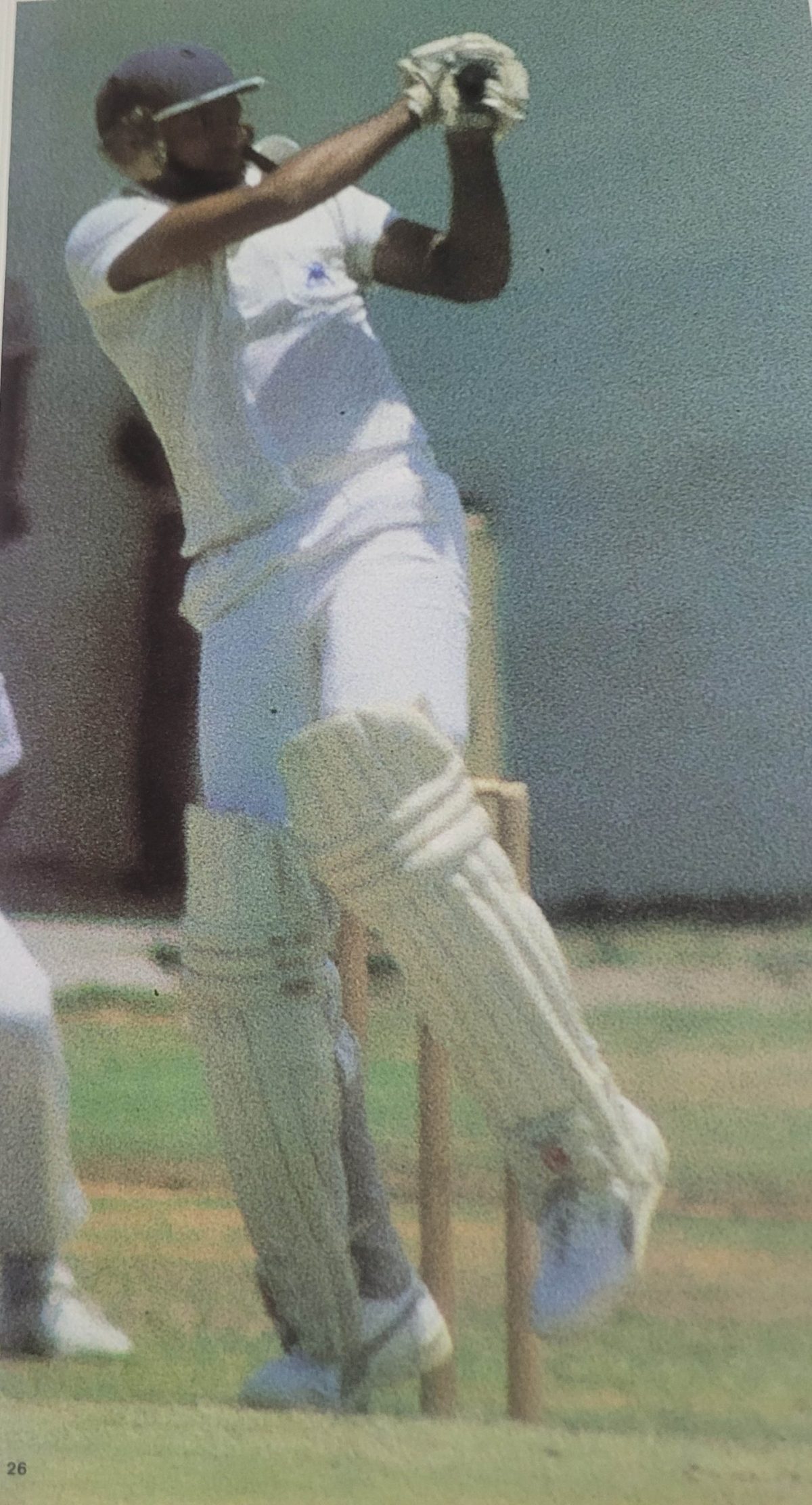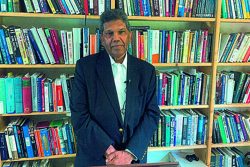In this week’s edition of In Search of West Indies Cricket Roger Seymour examines Mohinder Amarnath’s glorious run spree during India’s 1983 Tour of the Caribbean and the phenomenon whereby elite batsmen experience the euphoric sensation of being in a state of Nirvana, when runs gush from their bats for an extended period of time.
Prologue
It must be a burden being the son of a legend in the cricketing world, what with the immense weight of expectations being placed on your shoulders and the never ending stream of comparisons and analyses of performances. Lala Amarnath, who was often revered as the ‘Father of India’s Cricket’, must have been a tough act to follow. He scored India’s first Test century in the First Test on India’s soil, 15 – 18, December, 1933, versus England, at the Gymkhana Ground in Bombay, then the hub of India’s cricket, thus becoming the 17th batsman to attain the rare honour of making a century on Test debut. (K S Ranjitsinhji, 154* in 1896, and the Nawab of Pataudi, 102, in 1932, both from India, but playing for England against Australia, also managed the feat.) Lala top scored in both innings, 38 / 219, & 118 / 258, and shared a third-wicket partnership of 186, with India’s Captain C K Nayudu. According to reports, pandemonium broke out among the 50,000 spectators, who applauded long and loud, when Lala got to the landmark. Despite his heroic efforts, Lala couldn’t prevent a nine-wicket loss in four days.
Lala, whose career lasted over two decades, served as India’s first captain after Independence from England in August, 1947. Under his watch, which lasted until 1952, India won their first Test series, defeating Pakistan 2-1, in a five-match series at home, in 1952. He led India in 15 Tests, winning two, losing six and drawing seven. In 24 Tests Lala scored 878 runs at an average of 24.78, and took 45 wickets. In 186 first class matches, he scored 10,426 runs at an average of 41.37, including 31 centuries and 39 half-centuries, with 262, as his highest score.
Lala was later hired by the sports-loving Maharajah of Patiala to encourage the development of the game of cricket within his northern state. The patriarch then went on to become the chairman of selectors, manager, coach and a radio and television broadcaster. Renowned as a bit of a martinet, he influenced his three sons to love cricket to the exclusion of all other sports.
Mohinder Amarnath
Mohinder, the second son, is known as ‘Jimmy’ to friends and his team mates. In fact, everyone calls the affable fellow Jimmy. At the age of 19, Mohinder, was selected for the Fifth Test of the 1968/69 series versus Australia, at Madras. With India trailing 1-2, Mohinder was chosen as a medium pace, in-swing bowler (in the mould of his father) who could bat competently. Mohinder opened the bowling, and in the second innings, clean bowled Keith Stackpole (4) and Ian Chappell (5), with deliveries that cut back and hastened off the wicket to reduce Australia to 12 for two. The visitors slumped to 24 for six, before recovering to 153, and eventually winning the match by 77 runs to secure the series. Batting eighth, Mohinder had scores of 16* and 0. It was the start of a rollercoaster Test career, often falling in and out of the confidence of the Indian selectors.
Whilst Mohinder patiently awaited his next Test cap, history was being repeated. Lala, had endured a 12-year wait between his third Test match and his fourth, after being sensationally sent home during the early stages of the 1936 Tour of England, following a clash with India’s captain the Maharajkumar of Vizianagram (“Vizzy”). During that period of time, India’s cricket was run by the princes and the elite society. Whilst Lala, who had a reputation for speaking his mind, had seethed and raged, Mohinder focused on his batting and waited patiently.
Six years later, in January 1976, Mohinder was recalled for the First Test at Auckland in New Zealand, where the spotlight shone on his elder brother Surinder. Replying to the hosts’ total of 266, Surinder, batting at three, joined his captain Sunil Gavaskar on the loss of Dilip Vensarkar at 16. In just over four hours, Surinder outscored Gavaskar (116), in the 204-run, second-wicket partnership, thus emulating his father, with a century (124) on Test debut. His innings included 16 boundaries and one six, as both batsmen were the beneficiaries of three spilled chances. (A few months earlier he had also scored a century against Sri Lanka in an unofficial Test match.) Batting seventh, Mohinder, compiled 64, as he guided India to a total of 414, a lead of 148. Prasanna, eight for 76 in New Zealand’s second innings, exploited the turning pitch in the visitors’ favour as they romped home by eight wickets with a day to spare. New Zealand won the Third Test by an innings to square the series, as Richard Hadlee, seven for 23, scuttled India for 81 in the second innings.
Coming of age
Following the tour of New Zealand, India embarked on a 62-hour journey to the West Indies for a four-Test series. Two and a half weeks later, they were completely outplayed in the First Test in Barbados, losing by an innings and 97 runs with two days to spare. It is a tribute to their leadership and their indomitable spirit that they recovered to win the Third Test, by completing the highest run chase in the history of the game (In Search of West Indies Cricket, ‘India’s Glorious Run Chase’, 23 June, 2024). Gavaskar (102), and Gundappa Vishwanath (112) recorded centuries, but according to India’s captain Bishan Singh Bedi, “It was a knock [Mohinder’s] that actually paved the way to our triumph.”
Mohinder, who had been promoted to the critical number three slot in the Second Test, anchored the innings, batting for seven hours and 20 minutes, as Gavaskar, Vishwanath and finally, Brijesh Patel, 49*, attacked the West Indian bowling. He offered a single chance, a regulation return catch to Imitiaz Ali at 35, whilst coming of age in his seventh Test match. He was run out for 85, by Clive Lloyd’s direct throw from extra cover, with India 11 short of their famous victory. In the controversial Fourth Test, when Bedi declared India’s second innings closed at 97 for five, with five players ‘absent hurt’ in the official scorecard, Mohinder had contributed 59, with Dilip Vengsarkar’s 22, the only other score in double figures.
In the opening paragraph of the 1977 Wisden Cricketers’ Almanack’s summary “‘India in the West Indies 1976” the well-known Indian cricket journalist and broadcaster Dicky Rutnagur wrote: “At the end of the tour, the Indian team trudged along the tarmac towards their homebound aeroplane at Kingston’s Norman Manley Airport, they resembled Napoleon’s troops on the retreat from Moscow. They were battle-weary and a lot of them were enveloped in plasters and bandages.
“The bandages were campaign ribbons of a controversial and somewhat violent final Test which the West Indies won to prevail 2-1 in a four-Test series.”
Tony Cozier, editor of the West Indies Cricket Annual, in his summation of the tour in the 1976 edition observed, “No Indian reputation was enhanced more in the series than that of Mohinder Amarnath. He came as an all-rounder, batting in the lower half of the order. He left as an established No. 3, a natural striker of the ball who was never removed cheaply. He clearly has a long future in Indian cricket but will hardly play an innings as important as his marathon 85 in the second innings of the third Test.”
At the end of the hard fought 1977/78 five Test series in Australia, won 3-2 by the hosts, Gavaskar acknowledged Mohinder as the best fast bowling player in India’s side. Against the Jeff Thomson-led pace attack, Mohinder scored 90 and 100 on the fast pitch at Perth. After India had rebounded from 0-2 to tie the series, Mohinder spearheaded the charge in the final Test with an innings of 86, which lasted over five hours, as India chasing a target of 493 compiled 445.
Still, Mohinder bounced in and out of India’s Test side, unable to command a regular spot in the team. Dropped after the First Test of the 1978/79 home series versus the West Indies, Mohinder returned for the Sixth Test at Kanpur, where, batting sixth, he scored the third century in India’s mammoth total of 644 for seven declared.
Mohinder’s fearless approach to fast bowling was confirmed by his willingness to follow paternal instructions that “any short ball was there to be hooked.” Hooking requires great hand and eye coordination, the ability to pick up the length of the short ball very early, and most importantly, the courage to get inside the line and play the fast rising delivery in front of one’s face. In executing the shot properly, one must roll the wrists over to pull the ball down, if not, the ball will tend to loop upwards, more often not, presenting an easy catch for a fieldsman. (The ‘modern bats’ often facilitate mis-hooks carrying for sixes.) Great pure hookers are absolutely fearless and are few in number.
Mohinder’s propensity to play the hook shot (which was deemed responsible for the ‘ups and downs’ of his career), coupled with his refusal to wear a helmet had disastrous consequences. During the 1977/78 Tour of Australia, he was poleaxed by Sam Gannon. At Lahore, Pakistan, in 1978, he was felled by a short-pitched delivery from Safraz Nawaz, and had to be rushed for medical attention. During the 1979 tour of England, he was struck on the head six times. On the final occasion, in the murky light at Trent Bridge, in a match against Nottinghamshire, he missed a ball from Richard Hadlee, and suffered a fractured skull. Recalled for the Sixth Test at Wankhede of the 1979 home series against Australia, batting seventh, he emerged in a hunter’s cork hat (like Lala wore), and in attempting to hook (again!) fast bowler Rodney Hogg, fell on his wicket, after contributing two runs.
It looked like the end of the road for Mohinder. However, Lala’s son had other ideas. He opted to wear a helmet and changed his stance to appear, what is referred to, as ‘two-eyed’ at the crease. Of course, Jimmy continued hooking. In March 1982, Mohinder led Delhi to an improbable victory in the final of the Ranji Trophy, India’s premier first class competition. Replying to Karnataka’s colossal total of 705, Mohinder forced the game into an unprecedented sixth day, as he led the charge, batting throughout the fifth day, in an inspired captain’s innings of 185.
An unbroken ninth wicket partnership of 117, saw Delhi home and Mohinder lifting the coveted trophy.
Mohinder’s scintillating form at the start of the 1982 /83 Indian domestic season could not be ignored, and once again, the selectors recalled him. He scored 537 runs in six innings, making two centuries, at an average of 107.40, which eventually topped the averages. In mid October in the Duleep Trophy Final, Mohinder’s knocks of 80 and 67* led North Zone to an eight-wicket triumph over West Zone. In the Irani Trophy match – Ranji Trophy Champions (Delhi) versus Rest of India – Skipper Mohinder must have been rather disappointed that his scores of 127 and 52, were not enough to prevent defeat as the Rest of India scored 424 for five in four hours and 20 overs, after trailing by 162 in the first innings.
Selected for the 1982/83 Tour of Pakistan, Mohinder returned to the Test arena after an absence of three years. In the lopsided six-Test series, India was no match for the Imran Khan led Pakistan team. In defeating India 3-0, the Pakistani batsmen plundered the mild Indian attack. Imran captured 40 wickets, and as Qamar Ahmed stated in the 1984 Wisden Cricketers’ Almanack summary of the series, “… bowled with such venom and fire that no Indian batsman other than Mohinder Amarnath faced him with any confidence.”
Mohinder’s scores: First Test, Lahore, 109* in 383 minutes (Drawn). Second Test, Karachi, 5 & 3 (Lost by an innings). Third Test, Faisalabad, 22 & 78 (Lost by ten wickets). Fourth Test, Hyderabad, 61 & 64 (lost by an innings & 119 runs). Batted at No 3, after batting at No 5, in the first three Tests. Fifth Test, Lahore, 120 (Draw). Sixth Test, Karachi, 19 & 103* (Draw). 584 runs in ten innings at an average of 73.00.
Two weeks later, in February, 1983, India arrived in the West Indies for a five-Test series, and Mohinder’s relentless form showed no signs of abating.
In the First Test in Jamaica, he scored 29 and 40, and delivered the fateful final over as the West Indies scored an improbable victory (In Search of West Indies Cricket, ‘Magic at Sabina Park’ , 2 April, 2023). In the Second Test in Trinidad, he top scored in both innings, as he took the fight to the West Indies pacers. His first innings effort of 58 lasted three and a half hours, and his flawless match-saving knock of 117 in the second defied the bowlers for five and three-quarter hours, as he ignored hits on his helmet, glove and forearm. In the rain-affected Third Test at Bourda, Mohinder only managed 13.
In the Fourth Test in Barbados, on the fastest wicket in the Caribbean, India succumbed by ten wickets, with Mohinder standing on his own, as seven of his teammates fell to close catches off of bouncers. In the first innings, his countering attack approach to Roberts, Holding, Garner and Marshall, produced 91 of India’s 209 runs, and, of course, included hooked sixes off the latter three. In the second innings, he was forced to retire hurt at 19, after being struck on the mouth whilst attempting to hook (again!) Marshall. He resumed with India in dire straits at 139 for five, still 138 in arrears of the hosts’ score of 486. He immediately demonstrated that the blow had not affected his confidence in any way, by scoring with two hooks. With the aid of the wagging tail, and Mohinder’s rear-guard knock of 80, India managed to equal the West Indian score and avoid the embarrassment of an innings defeat.
In the Fifth Test at Antigua, Mohinder had just hit his stride, hooking successive deliveries from Holding for a six and a four, when he collapsed onto the pitch just before lunch on the first day, a victim of leg cramps brought on by a virus. Resuming the next day with a runner, he got his third consecutive 50 (54) as India reached 457 on the perfect batting surface. The hosts replied with 550, with Greenidge, Haynes, Dujon and Lloyd, all scoring centuries. With the match petering out into an inevitable draw, Mohinder, playing with complete authority, collected yet another century, 116. It was the 3rd May, the earliest date a batsman had ever completed 1,000 Test runs in a calendar year. His 598 runs, at an average of 66.44 for the series, made his Man of the Series a foregone conclusion.
All told, Mohinder made 959 runs in the first-class matches on the tour. In the territorial matches, he scored 82 off Jamaica, hit 114 off the Trinidadians, and 121 against Guyana (non first class) in a match reduced to two days because of the weather. Forced to bat ninth in the second innings in Barbados, because of a groin strain, Mohinder scored 101 not out (following his first innings top score of 61), whilst adding 163 for the eighth wicket with Gurusharan Singh (89), to stave off a fourth consecutive defeat by the island over Indian touring teams.
During the 1982/83 season Mohinder made more runs – 2,355 , at an average of 81 – than anyone else ever had in a first-class season outside of England.
Still on the crest of a tidal wave, three months later, Mohinder won Man of the Match awards in the semifinal and final of the 1983 World Cup. In the final, his 26 occupied two hours and held the Indian innings together, and when Dujon and Marshall threatened to swing the tide in favour of the West Indies, he returned to the attack and dismissed both players.
And then, inexplicably, Mohinder’s form vanished. In the latter months of 1983, he failed to get into double figures in two home Tests against Pakistan. Worse was to follow. In the six Test series versus the West Indies, Mohinder played in the First, Second and Fifth Tests, and had scores of 0, 0, 1, 0, 0 & 0. It didn’t matter where he batted in the order; third, sixth, seventh, seventh, fourth, fourth. Nothing helped. At least the selectors spared him the ignominy of equalling or surpassing Australian fast bowler Alan Hurst’s record of six ducks in a series. He had become the fifth member of the club of players with five ducks in a series, and the first to achieve the dubious feat in just three Tests.
Very few batsmen came to the West Indies and plundered the pace quartet at its peak in such a fearless manner for an entire series. Hats off to Jimmy.
Notes
Mohinder returned to the side a year later, and played the last of his 69 Tests in 1986, having scored 4,378 runs at an average of 42.50, including 11 centuries.
On 6th December, 2009, the Board of Control for Cricket in India presented Mohinder Amarnath with its Lifetime Achievement Award.
Viv Richards opined, “I have not seen anyone play the Windies pace quartet with the mastery Amarnath demonstrated.”
Sunil Gavaskar wrote, “Jimmy must be the bravest of Indian batsmen.”
Here are two excerpts from Jimmy’s interview in December 2009, with Mid Day, a media outlet in India.
You got hit a few times while batting. Which blow was the worst?
I am very clear about one thing: When you are playing this sport against fast bowlers, you should be prepared to get hit. It shouldn’t be very serious, but even if it is, it’s part and parcel of the game. The important thing is how strongly you come back. Getting hit didn’t affect me as an individual. I went in again because the best way to get over your fear is to be positive and more aggressive. That attitude helped me.
In 1988, you called the selectors a bunch of jokers. Do you regret doing so?
No, I don’t. Whatever I said was the truth and truth always hurts. When you speak the truth, you have to be prepared to accept ire. It didn’t bother me at all. I thought then things were wrong and I just freed my mind. I was getting a raw deal on a number of occasions. I had kept mum, but then came a boiling point.
Previous articles in this series examining this theme are: ‘The Port-of-Spain Masters’ [Sunil Gavaskar], 13, March 2016; ‘Lost in the Shuffle’ [Patsy Hendren], 22 May, 2016; ‘1976 – The Year of the Dragon(s)’ [Viv Richards], 17, & 24, July, 2016.










